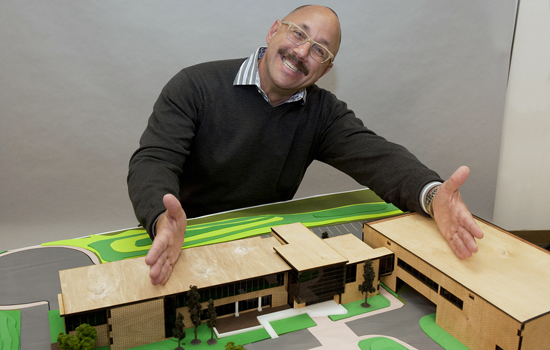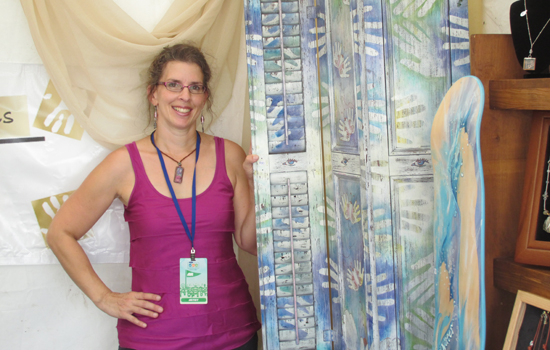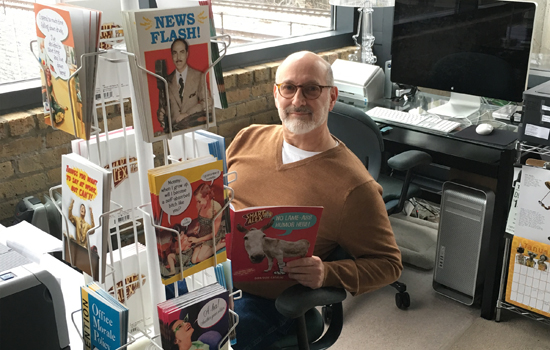RIT/NTID grads show who’s boss
For 35 years, Jay Blumenfeld ’74 (professional photography) has owned Smart Alex, a Chicago-based manufacturer and distributor of greeting cards known for its humorous and edgy cards.
Graduates of RIT/National Technical Institute for the Deaf are making their mark when it comes to being the boss and running their own businesses. Among the roughly 1,200 self-reported deaf business owners in the United States, RIT/NTID graduates make up nearly one-fifth of that number, with more than 200 graduates owning a business. According to W. Scot Atkins, a nationally recognized deaf entrepreneurship expert and business studies professor at NTID, that number is expected to skyrocket. Atkins said that with enhanced services and training provided by colleges like NTID, a strong university infrastructure that supports deaf entrepreneurship and the development of initiatives to further connect deaf students with successful business mentors, more deaf and hard-of-hearing graduates will realize their potential when it comes to owning a business. Meet three RIT/NTID graduates whose businesses have thrived under their leadership.
Greeting card distributor
Jay Blumenfeld ’74 (professional photography) admits that two things have greatly improved the odds that his greeting card company remains successful—his twisted sense of humor and his grandmother, Ruth, who, at age 91, was the cover girl for his first line of cards.
For 35 years, Blumenfeld has owned Smart Alex, a Chicago-based manufacturer and distributor of greeting cards, with more than 19 million cards sold. And Blumenfeld, who is a master of “pushing the envelope,” so to speak, happily walks the fine line between sidesplitting humor and sheer irreverence.
Raised in Minnesota, Blumenfeld said he believes in destiny, especially when he considers the unusual path he took on the way to becoming a greeting card mogul. After earning his photography degree from RIT/NTID, he planned to use his collection of images to craft a coffee table book on alternative lifestyles.
“I pictured folks smiling at topics that were often considered taboo,” he said. “When I showed the idea to art directors and publishers, they all said, ‘Why don’t you do greeting cards instead?’”
Growing up, Blumenfeld said, he found inspiration in the creativity of Peter Max, Andy Warhol and others like them who broke the mold and challenged the status quo. And in true entrepreneurial fashion, Blumenfeld has learned a classic survival technique—embracing the evolution of the industry. The company recently closed its brick-and-mortar warehouse and is now a print-on-demand business, with orders processed online and shipped from a fulfillment center. He has also embraced the challenges that he has faced throughout his decades as an entrepreneur.
“In the early 1980s, there wasn’t much in the way of technology to help me,” he said. “There were no fax machines, pagers, email, relay services or videophones. I had to rely on hearing people to make phone calls. But today, with all of the advanced technology, there is little I can’t do as a deaf person.”
One thing Blumenfeld said hasn’t changed is the popularity of his first card model, Grandma Ruth. “She seems to be impervious to the changing times and trends. Over the past three decades, she has appeared on millions of greeting cards, and her cards have never fallen off my best sellers list.”
Architectural firm owner
It was 1985 and Philip Rubin’s last straw came when the owner of the firm he was working for refused to allow him to interact with the clients, claiming the clients would be inconvenienced.
Until then, Rubin hadn’t considered running his own architectural firm, but the events of that day, along with some people—hearing and deaf—who questioned his professional abilities, opened his eyes to the possibility of making his own business decisions, ensuring workplace flexibility and maintaining control of his designs.
Today, Rubin is celebrating 30 years as owner of Corey Design Studio in Palm Springs, Calif., where he utilizes the concepts of accessibility, feng shui, flow and function in his environmentally conscious residential and commercial/industrial designs. To date, he has worked with more than 100 clients across the country.
In the early 1970s, Rubin, a Chicago native, studied in NTID’s associate in architecture program. He continued to study at Cornell University for his bachelor’s degree. He credits the blend of deaf and hearing students living and learning together at NTID, as well as support services, for helping him develop the leadership skills he needed to branch out on his own.
“In the beginning, it was tough,” recalled Rubin. “When I started my own business, I had to pool some money with another deaf entrepreneur to hire a secretary to handle telephone calls. I sometimes resorted to paper and pen or drawings for communication. Now with email, texting and videophone relay service, my life is so much easier.”
Rubin also believes that today’s deaf entrepreneurs may be able to find success because hearing people are more familiar with deaf culture and there are more technologies to harness. “The attitudes of hearing people toward the abilities of deaf people continue to improve thanks to public media including television, movies, print media and social media,” he added.
Depending on his clients’ listening abilities, Rubin uses his own speaking and lip reading skills, or sometimes a text pager or drawings for communication. He sometimes utilizes gestures to make a point— “thanks to my theater background at NTID and the National Theater of the Deaf.” His husband also serves as an interpreter.
“The principles of entrepreneurship apply to everyone; it doesn’t matter if you’re deaf or not,” he said. “If there’s one thing that I have learned throughout this whole experience, it’s to own the business and not to allow it to own you.”
Jewelry designer
Since she was a child, Michelle (Johnston) Osterhout ’87, ’93 (SVP, graphic design) has been fascinated with creating unique jewelry and artwork. She would often pick up broken glass and metal she found lying in the road and save them for later when she had time to incorporate them into one-of-a-kind pieces.
“I remember one day that I came across pretty beads at a garage sale,” recalled Osterhout. “I pieced them together with the lost-and-found metal and made a simple necklace tied using fishing line in a crude knot—with my teeth. I gave it to my mother. I was so proud. That was the beginning.”
Osterhout still maintains that same passion for handcrafted pieces that can’t be replicated and, for the past 10 years, has owned ~elle’s expressions in her native Michigan, her vehicle for designing, creating and sharing personalized jewelry and artwork with the public. She sells her pieces at art shows annually and also donates several pieces to nonprofit organizations to boost their fundraising efforts. She also sells her pieces to private collectors.
Growing up in a deaf, artistic family, she was encouraged to develop her homegrown talents. At RIT, she enjoyed classes in metalwork, printmaking, drawing and photography—all useful skills for her metal jewelry designs, cherry wood necklaces, stained glass projects and other eye-catching sustainable and “upcycled” art.
“I don’t have a drawing beforehand, but I create my art from what I see in my mind’s eye. I find art as a way to close the gap between different worlds—to help educate and bridge communities, and to help show that we are alike, yet different in ways that we can respect.”
Osterhout often still employs the same techniques she used when she was young.
“The windows I create are not your average stained-glass artwork, but rather glass that I find—bowls, cups, plates, trays, store-bought glass or broken glass that I find or break myself. It’s all art.”
And she has learned a few newer lessons along the way. “If you find it in your heart to own a business, then do it,” she says. “The sky is the limit. I’ve learned to overcome obstacles when the mind says I can’t. And while it’s true that sometimes what you study in college doesn’t turn out to be what you desire, you should remember that it will lead you to the highway—that is your life.”
 Philip Rubin, a former RIT/NTID student, has owned the architectural firm Corey Design Studio in Palm Springs, Calif., for 30 years. He credits his time at NTID for helping him to develop leadership skills needed to start a business. Mark Benjamin
Philip Rubin, a former RIT/NTID student, has owned the architectural firm Corey Design Studio in Palm Springs, Calif., for 30 years. He credits his time at NTID for helping him to develop leadership skills needed to start a business. Mark Benjamin Michelle (Johnston) Osterhout ’93 (graphic design) uses a mixed media approach to creating her unique artwork for ~elle’s expressions, the business she has owned for 10 years.
Michelle (Johnston) Osterhout ’93 (graphic design) uses a mixed media approach to creating her unique artwork for ~elle’s expressions, the business she has owned for 10 years.



